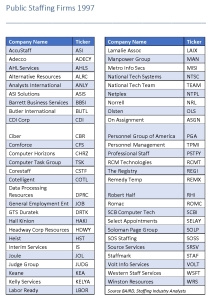In a 2001 interview, I said, “You can’t move forward if you’re looking back.” I was recently reminded that survival in this ever-changing industry shouldn’t be taken for granted. With increasing customer demands and technology evolving daily, we are blessed to be one of the few companies that has survived and prospered. As I think about the “Fastest-Growing Staffing Firms” in this issue’s cover story, I reflect on what has helped us and other successful firms scale and thrive in an industry that has changed drastically over the last two decades.
Twenty-two years ago, Kforce (then known as Romac International) joined the ranks of 53 staffing firms on the Nasdaq stock exchange. Today, only a few of those are left standing — the rest having been acquired or simply gone out of business. During the rapid industry growth of the mid- to late ’90s, companies had to grow through acquisitions to achieve the scale necessary to compete effectively. Kforce consummated more than 20 acquisitions, the largest being that of Source Services in 1998, which significantly expanded our geographic reach in the US.
Click chart to enlarge.
 We could offer more services to clients in more locales, making us a national provider in IT and finance and accounting. Kforce has been fortunate to have a heritage rooted in the professional and technical segments while other firms, especially large clerical and industrial firms, had to acquire platforms in the technical and professional segments, often creating channel conflicts.
We could offer more services to clients in more locales, making us a national provider in IT and finance and accounting. Kforce has been fortunate to have a heritage rooted in the professional and technical segments while other firms, especially large clerical and industrial firms, had to acquire platforms in the technical and professional segments, often creating channel conflicts.
Along with the advent of technology, the speed of the business has increased dramatically. Cycle times went from months or weeks to days and minutes. “Delivery” meant getting into your car and driving envelopes full of résumés to clients. Email or fax machines were still not the norm, and there were no cell phones. There were only fast cars and speeding tickets. Today, social media, texting, email and a plethora of tools have sped up the process dramatically.
The dot-com boom ushered in a new era of high-speed internet connection to clients and candidates/consultants. Applications rapidly evolved with CRM, ATS, ERP and websites fully integrated. Customer expectations rose as technology changed the way we engaged through tools for candidate submission and time entry/payroll.
The few of us from the ‘90s and early 2000s that are still standing today have targeted fast-growth segments with consistent operating models. We positioned ourselves to take advantage of the radical changes and adapted quickly, adjusting service offerings. In the past five years, Kforce has adapted by selling off products, such as our clinical research and healthcare information management divisions, to focus only on technology and finance and accounting. We are adjusting our market strategy and realigning our business model, investing in technology to improve productivity and efficiency today and prepare for the rapidly approaching Uber moment.
So my advice to those “fast-growing companies” today differs from what I said in that 2001 interview. Today, I advise them to learn from the past and look outside our industry to see how to adapt and prepare for rapid change. The application of technology is a focus for all organizations and in some situations, smaller firms have an advantage as they can be more nimble. Lastly, the key to longevity in this industry has been and continues to be the people. Regardless of technology, it’s still about relationships. In that same interview, I said “The internet will never change the fact that people will always be at the core of staffing.” Many things change, and some things remain the same. This will be tested again as artificial intelligence and new models bring new opportunities. I would like to take this opportunity to thank and express my admiration and respect for my peers. I have had the privilege of competing with and learning from all of you, and I am grateful. Press on.







